Blue Ensign

The Blue Ensign is a flag, one of several British ensigns, used by certain organisations or territories associated with the United Kingdom. It is used either plain, or defaced with a badge or other emblem.
The evolution of the Blue Ensign followed that of the Union Jack. The ensign originated in the 17th century with the St George's cross (the Flag of England) in the canton, and with a blue field (top right).
The Acts of Union 1707 united England and Wales with Scotland in the Kingdom of Great Britain, thus producing a new Blue Ensign with the new Union Flag in the canton. With the Act of Union 1800, Ireland joined the United Kingdom and St Patrick's Cross was added to the Union Flag and, accordingly, to the cantons of all British ensigns from 1 January 1801.
-

 The modern Blue Ensign of the United Kingdom
The modern Blue Ensign of the United Kingdom -
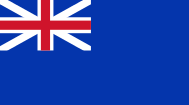
 The British Blue Ensign (1707–1801)
The British Blue Ensign (1707–1801) -

 English Blue Ensign as it appeared in the seventeenth century.
English Blue Ensign as it appeared in the seventeenth century.
Plain blue ensign
Prior to the reorganisation of the Royal Navy in 1864, the plain blue ensign had been the ensign of one of three squadrons of the Royal Navy, the Blue Squadron. This changed in 1864, when an order in council provided that the Red Ensign was allocated to merchantmen, the Blue Ensign was to be the flag of ships in public service or commanded by an officer in the Royal Naval Reserve, and the White Ensign was allocated to the Navy.
Thus, after 1864, the plain blue ensign (i.e., without any defacement or modification) is permitted to be worn, instead of the Red Ensign, by three categories of civilian vessel:[1]
- British merchant vessels whose officers and crew include a certain number of retired Royal Navy personnel or Royal Navy reservists, or are commanded by an officer of the Royal Naval Reserve in possession of a Government warrant. The number and rank of such crew members required has varied over the years, as have the additional conditions required, since the system was first introduced in 1864.
- Royal Research Ships by warrant[lower-alpha 1] whether manned by former Royal Navy personnel or Merchant Navy personnel.
- British-registered Yachts belonging to members of certain long-established yacht clubs, such as the Royal Thames Yacht Club, Royal Engineers Yacht Club, The Royal Motor Yacht Club, the Sussex Motor Yacht Club, and the Royal Northern & Clyde Yacht Club. Many more yacht clubs use Blue Ensigns that are defaced by badges (e.g., Royal Gibraltar Yacht Club, Royal Ulster Yacht Club, etc.).
Permission for yachts to wear the blue ensign (and other special yachting ensigns) was suspended during both World War I and World War II.
Defaced blue ensign
Since 1864, the Blue Ensign is defaced with a badge or emblem, to form the ensign of United Kingdom government departments or public bodies, for example:-
-

Ensign of the Royal Fleet Auxiliary
-

Ensign of the defunct Royal Maritime Auxiliary Service
-

Ensign of the defunct Royal Navy Auxiliary Service
-

Ensign of the Northern Lighthouse Board
-

Ensign of the Scottish Fisheries Protection Agency
-

Ensign used by maritime departments of the Government of Bermuda.
-

Royal Engineers Ensign
-

Ensign used on Royal Logistic Corps vessels commanded by a Commissioned Officer.
-

Ensign used on Royal Logistic Corps vessels commanded by a Non-Commissioned Officer.
-

HM Customs & Excise. Superseded by the UK Border Agency on 1 April 2008.
-

Ensign of the Sea Cadet Corps
-
Ensign of Her Majesty's Coastguard
- Vessels belonging to members of certain British Yacht Clubs (for example, the Cruising Association, Parkstone Yacht Club, the Royal Harwich Yacht Club, and the Royal Bermuda Yacht Club). Some yacht clubs in Canada (e.g., the Royal Canadian Yacht Club (Toronto), the Royal Kennebecasis Yacht Club, and the Royal Vancouver Yacht Club) were initially granted British Admiralty warrants to use various versions of the Blue Ensign, and in 1938, this authority was transferred to the Canadian Defence Ministry, which then issued special ensign warrants to Canadian yachts thereafter. At the same time, the Canadian Defence Ministry determined that all privileged Canadian clubs would use the Canadian Blue Ensign as opposed to the plain version or a club-defaced version. When the Canadian National Flag was introduced in 1965, the Blue Ensign in all its forms became obsolete in Canada, but several privileged Canadian yacht clubs have continued to display the Canadian Blue Ensign or their pre-1938 Blue Ensign unofficially.

- Government vessels of UK overseas territories. This usage stems from the fact that in 1867–69, orders in council provided that the ensign for vessels in the service of any of the British colonies was to be the Blue Ensign, charged in the fly with the seal of the colony. Any British colony with ships in its service thus had reason to use the Blue Ensign. This worldwide, imperial use is the origin of the use of the Blue Ensign by many areas today, such as the Australian states. Although the distinguishing flag of Bermuda is a defaced red ensign, its government marine services (police, ferries, etc.) fly a defaced blue ensign from both vessels and shore facilities.
The defaced blue ensign was formerly used as:
- The jack of the Royal Canadian Navy from its inception until the adoption of the Maple Leaf flag in 1965. (see Flags of the Royal Canadian Navy 1910–1965) The blue ensign was approved by the British Admiralty in 1868 for use by ships owned by the Canadian government.
-

 Blue Ensign worn as a jack by the Royal Canadian Navy from 1921–1957 (with green maple leaves in the shield)
Blue Ensign worn as a jack by the Royal Canadian Navy from 1921–1957 (with green maple leaves in the shield) -

 Blue Ensign worn as a jack by the Royal Canadian Navy from 1957–1965 (with red maple leaves in the shield)
Blue Ensign worn as a jack by the Royal Canadian Navy from 1957–1965 (with red maple leaves in the shield)
- The ensign (1879-1928) and the jack (1928-1947) of the Royal Indian Navy (HM Indian Marine: 1879-1892, Royal Indian Marine: 1892-1934, Royal Indian Navy: 1934-1950):
-

 Blue Ensign worn as an ensign (1879-1928) and a jack (1928-1947) of the Royal Indian Navy[1]
Blue Ensign worn as an ensign (1879-1928) and a jack (1928-1947) of the Royal Indian Navy[1]
Flags of UK Overseas Territories using the Blue Ensign
Current flags:
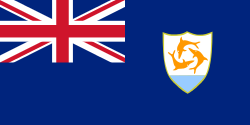 Flag of Anguilla
Flag of Anguilla Government Ensign of Bermuda (the flag commonly used on land is Bermuda's Red Ensign)
Government Ensign of Bermuda (the flag commonly used on land is Bermuda's Red Ensign)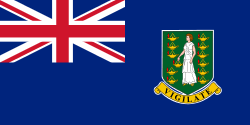 Flag of the British Virgin Islands
Flag of the British Virgin Islands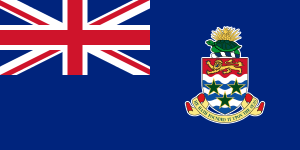 Flag of the Cayman Islands
Flag of the Cayman Islands Flag of the Falkland Islands
Flag of the Falkland Islands Government Ensign of Gibraltar (there is another flag, not based on an ensign, that is commonly used on land)
Government Ensign of Gibraltar (there is another flag, not based on an ensign, that is commonly used on land) Flag of Montserrat
Flag of Montserrat Flag of Pitcairn Islands
Flag of Pitcairn Islands Flag of Saint Helena
Flag of Saint Helena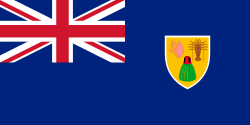 Flag of Turks and Caicos Islands
Flag of Turks and Caicos Islands
Former flags:
 Flag of The United States of the Ionian Islands (a British amical protectorate, 1815–1864)
Flag of The United States of the Ionian Islands (a British amical protectorate, 1815–1864).svg.png) Flag of British Hong Kong (1870–1997) and the ensign of the Royal Hong Kong Police Force were based on the Blue Ensign.
Flag of British Hong Kong (1870–1997) and the ensign of the Royal Hong Kong Police Force were based on the Blue Ensign.
National flags based on the Blue Ensign
These include:
 Flag of Australia
Flag of Australia
 Flag of Fiji (light blue)
Flag of Fiji (light blue) Flag of New Zealand
Flag of New Zealand
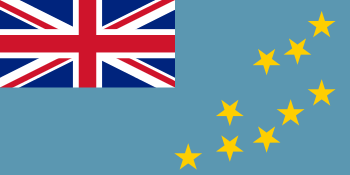 Flag of Tuvalu (light blue)
Flag of Tuvalu (light blue)
Other flags based on the Blue Ensign
See also
- British ensign
- Australian flag debate
- New Zealand flag debate
- Green Ensign
- Red Ensign
- White Ensign
- Ensign
References
- Notes
- ↑ An individual warrant is issued by the Secretary of State for Defence for each ship
- Footnotes
- ↑ Naval Staff Directorate. "Naval Flags and Ensigns" (PDF). p. 12. Retrieved 1 January 2013.
External links
| Wikimedia Commons has media related to Blue ensigns. |
- Blue Ensign page on the "Flags of the World" website
- UK, Naval, Government, Yacht clubs on flags.net
| ||||||||||||||||||||||
